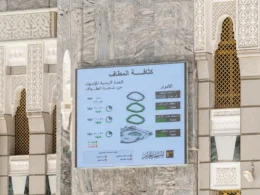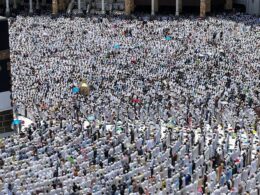Hajj 2025 concluded today, June 6, 2025 (10 Dhul Hijjah 1446), with a total of 1,673,230 pilgrims completing the pilgrimage-the lowest turnout in three decades outside the Covid-19 period, according to data released by the Ministry of Hajj in X.
The figure marks a drop of nearly 160,000 pilgrims compared to the 2024 season and falls well short of pre-pandemic levels when hajj attendance routinely topped two million.
Of those participating this year, 1,506,576 were international pilgrims while 166,654 were residents of Saudi Arabia .
In contrast, the record-breaking 2012 hajj drew 3.16 million worshippers , highlighting a substantial drop in numbers for 2025. Officials have not offered an official explanation, but several contributing factors are apparent.
Economic challenges are a major concern. Global inflation and rising costs for travel, accommodation and sacrificial animals are placing a heavier financial burden on pilgrims—especially those from low-income communities in South Asia and Africa, who have historically supplied the bulk of the hajj pilgrims.
The increased costs appear to have deterred some would-be pilgrims from making the journey.
Stricter entry protocols also play a role. Health and vaccination requirements, stricter visa processing and tightened screening — measures introduced during the pandemic — are set for Hajj 2025.
Statistics
| Year | Total Pilgrims |
|---|---|
| 1995 | 1,781,370 |
| 1996 | 1,865,234 |
| 1997 | 1,942,851 |
| 1998 | 1,832,114 |
| 1999 | 1,831,998 |
| 2000 | 1,839,154 |
| 2001 | 1,913,263 |
| 2002 | 1,944,760 |
| 2003 | 2,041,129 |
| 2004 | 2,012,074 |
| 2005 | 2,164,469 |
| 2006 | 2,130,594 |
| 2007 | 2,454,325 |
| 2008 | 2,408,849 |
| 2009 | 2,313,278 |
| 2010 | 2,789,399 |
| 2011 | 2,927,717 |
| 2012 | 3,161,573 |
| 2013 | 1,980,249 |
| 2014 | 2,085,238 |
| 2015 | 1,952,817 |
| 2016 | 1,862,909 |
| 2017 | 2,352,122 |
| 2018 | 2,371,675 |
| 2019 | 2,489,406 |
| 2020 | ~ 1,000 |
| 2021 | 58,745 |
| 2022 | 926,062 |
| 2023 | 1,845,045 |
| 2024 | 1,833,164 |
| 2025 | 1,673,230 |
These protocols, while intended to safeguard public health, result in longer processing times and add bureaucratic hurdles for would-be pilgrims.
Another important factor is the extreme heat. Temperatures in Mecca and the surrounding pilgrimage sites often exceed 40 °C (104 °F) throughout the season.
Although authorities have expanded shaded areas by 50,000 square meters, deployed more than 400 cooling stations, and placed additional medical teams across key sites, many pilgrims may have chosen to postpone their pilgrimage rather than face the intense conditions.
On June 6, 2025, pilgrims gathered on Mount Arafat to perform the central rites of the Hajj, spending hours in worship and reflection under the hot sun.
Arafat – a site of great significance in Islam as the location of the Prophet Muhammad’s final sermon – became the spiritual center of this year’s pilgrimage. Despite challenging weather, those on Arafat fulfilled their duty, demonstrating resilience and devotion.
Regional officials reported that over 250,000 personnel from more than 40 government agencies collaborated to ensure health, safety and logistical support throughout the pilgrimage. These coordinated efforts ensured that, despite the heat and lower attendance, Hajj 2025 concluded without any major security or health incidents.
Analysts point to economic hardship, ongoing health precautions and extreme temperatures as the main reasons behind the lowest attendance in 30 years outside of the pandemic.
Saudi authorities are expected to review these factors and consider adjustments to facilitate greater accessibility and affordability for pilgrims in the future, while maintaining the necessary safety measures.









